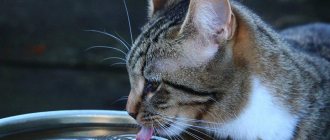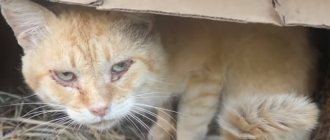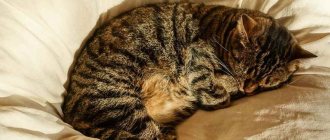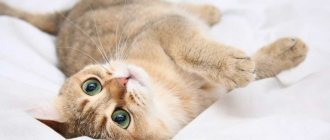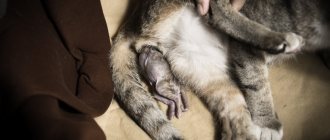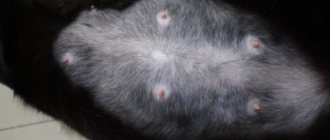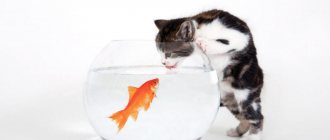How much should a cat weigh depending on age and breed: table
Animals of different sexes, breeds and ages weigh differently. Indicators of average body weight in grams and permissible deviations are shown in the tables:
Mongrel cats
British
Maine Coon
The table shows that males are larger than females throughout their development. The weight of newborns depends on the number of kittens, and the intensity of development in the first weeks of life depends on the milk production of cats. A standard has been developed for each breed, which specifies the minimum and maximum limits.
The health status of the pet is assessed based on whether the live weight corresponds to the reference weight. For adult animals, it is not so much the live weight that matters, but rather the condition of nutrition.
Cat weight at 8-12 months
By the time a cat is one year old, it is considered an adult. Its dimensions practically do not change, and on average reach 4-6 kg depending on the breed and gender. By the age of one year, it is necessary to reduce meals to two times a day and monitor its balance. It is important to feed animals with good food, in which the protein level is more than 30% (if we talk about industrially produced feed). High-quality balanced nutrition will be the key to the normal functioning of the cat’s body and is the prevention of obesity.
Estimating the weight of cats and cats
When assessing live weight, the season of the year and the physiological state of the pet should be taken into account. Cats that regularly walk outside, like wild animals, gain weight in the winter because their physiology is tuned to heat from the inside, due to the fat accumulated from excess food consumption.
In the summer, cats lose a lot of weight because they eat little. This is how the animal is protected from overheating. During sexual arousal, cats lose weight.
For cats, the season plays a role, but to a lesser extent than for males. But pregnancy leaves its mark: the female sharply gains weight due to embryos and amniotic membranes. After lambing and feeding the cubs for a month and a half, a cat can lose a lot of weight.
Cat underweight
Deficiency occurs in the following cases:
- Unbalanced diet or insufficient feed. It is necessary to monitor whether the pet is eating enough. Use ready-made feed of premium class or higher.
- Lactation - a nursing mother needs three times more calories than a single cat. Therefore, during this period they practice ad libitum feeding with energy-rich foods. The best choice of ready-made dry food for kittens and adolescents.
- Obstruction or obstruction of the intestines due to blockage by trichobezoars - hairballs soaked in semi-digested food. Prevent regular brushing. the use of specialized feed that prevents the formation of stones, the use of malt paste.
- High worminess.
Average weight of a cat
If the cat looks graceful, its coat is shiny, and its hours of sleep alternate with periods of high activity, then it is healthy and has an optimal weight. In this case, you don’t have to weigh it unless necessary.
Overweight cat
In healthy animals, excess weight is temporary. For example, the housewife was cutting up fish or meat and the purr ate to his fill. Obesity indicates the onset of the disease.
Castrati suffer the most from excess weight. They do not walk on the street, spend their entire lives in an apartment, and have no sexual motivation. A radical measure to combat excess weight is the use of specialized food for sterilized cats. They contain a lot of fiber, which causes a feeling of fullness before the animal has time to consume extra calories.
Specialized foods have also been developed for obese, uncastrated pets. Excess weight can be caused by chronic diseases and old age. In such situations, you should contact your veterinarian.
Weight deviation from the expected weight and its impact on health
You need to know about the negative health consequences of both overweight and underweight pets. Excess weight above normal can cause various diseases (diabetes, cardiovascular and gastrointestinal diseases, arthritis) and reduce life expectancy. Obesity is especially dangerous for young cats. Insufficient weight appears due to poor feeding of the cat or due to the presence of certain diseases (metabolic disorders, diseases of the gastrointestinal tract, cancer) and can lead to the development of hypovitaminosis and exhaustion.
© shutterstock
How much does a cat weigh?
A kitten in the house means happiness and also great responsibility. Every owner knows that for any animal it is necessary to provide proper living conditions so that it feels comfortable. For example, in our case, it is imperative to provide the kitten with food that is suitable specifically for its body. After all, health directly depends on what your pet eats. And one of the best indicators of health is weight gain. Let's take a closer look at how much a kitten and an adult cat should weigh, and also study the subtleties of the weight of different breeds.
The effect of castration/sterilization on weight
Sterilization or castration itself does not affect weight gain, but adult cats after such a procedure need to reduce the calorie content of their daily diet by a third, since their metabolism and hormonal levels change.
© shutterstock
Dependence of weight on gender, lifestyle
Males are usually 1-2 kg larger than cats of the same breed. If the mother cat is large, then her kittens will most likely be large.
Pets that lead a sedentary lifestyle and do not have difficulty getting food, unlike stray cats, are more likely to gain excess weight.
Why define?
When a baby is born, one of the first indicators that is noted is its weight. Good weight is the first sign of health. Not the only one, but one of the most important. It's the same with animals. There are weight standards that correspond to each cat breed. Basically they are about the same when the kitten is just born. As adults, norms change. Determining and monitoring weight throughout your pet's life is mandatory. By weight, you can determine overfeeding or underfeeding, an impending or progressive disease, or development.
When born from the same mother, you can compare the weight of kittens even without special instruments. Just looking at them is enough. If the kitten is thinner than the others, then special monitoring is required: behavior, feeding, sleep. If it is visually unclear that the kitten is thinner than the others, then you can watch how he attaches to the breast.
If other, stronger kittens push him away, then you need to take the kitten and bring it to the cat yourself, and more often than the others eat.
Kitten weight by month
The approximate weight of a kitten at birth varies from 80 to 150 grams. It depends on the breed and body structure of the baby. A one-month-old bobtail and Maine Coon kitten will be very different from each other, since these breeds are completely opposite in size.
Let's look at the table of the average standard weight of a kitten by month up to a year.
- In the first month, the average weight of a kitten is 110 grams. This is the weight that is considered quite normal for a baby and characterizes its healthy development. The behavior of newborn kittens can be compared to human children - they only eat and sleep. The daily weight gain of a cat in the first month of life is approximately 10-15 grams, that is, 70-100 grams per week.
- A two-month-old kitten gains about 300 grams of weight. But weight gain of up to 500 grams is considered normal. In the second month, the kitten stops feeding only on mother's milk. His diet must contain unlimited amounts of water, and you can also gradually include chopped meat and fish in your diet.
- At 3 months, the weight ranges from 1.2 to 1.7 kg, and the diet includes complete nutrition. The main thing is to make a choice: to feed the kitten with natural products or specialized food. Combined nutrition should be excluded, as the stomach may not cope.
- At 4 months the weight should already be 2 kg.
- At 5 months, the kitten weighs about 2.5 kg and eats only during the day.
- At 6 months, when molting is already possible, and in girls - puberty, the weight is 3 kg.
- After six months, weight gain will be less intense - about 100-150 grams per month. Thus, by the age of one year, the weight of an ordinary kitten will be about 4 kg.
Large individuals, such as the aforementioned Maine Coons, can reach a weight of 5-6 kg by year. And miniature breeds can be as little as 3 kg.
We must not forget that males are most often larger than females. And their weight by the end of the first year of life may be one kilogram higher.
Table with average weight indicators by months of development.
Weight of kittens depending on the number in the litter
The larger the litter, the greater the likelihood that among the kittens there will be weak babies.
The more kittens, the less milk the cat has
The number of newborn kittens also affects their weight gain in the first months of life. At the same time, a cat can fully feed up to 6 kittens. If more were born, someone will inevitably be malnourished. The most agile brothers and sisters will occupy the mother cat's nipples, not allowing the weak kittens to fully feed. If the kitten constantly squeaks, cannot get close to the nipple, or is pushed away by other kittens, feed the baby additionally with a special mixture.
How much do adult cats weigh?
Lifestyle, castration, nutrition, maintenance - all these are factors directly related to a cat’s body weight. The life of an adult cat differs little from that of a kitten if it lives in a family. The main thing is to prevent underfeeding or overfeeding the animal, otherwise problems with the gastrointestinal tract may arise.
A domestic cat usually weighs between 2 and 7 kg. A lot depends on the breed, and also on age. By old age, the pet will weigh less than, for example, at 2 years. And a Siamese cat will weigh less than a Norwegian Forest cat. Persians and British will weigh on average about 6 kg. But the weight of a Maine Coon can reach 13 kg.
Health problems
An overweight cat can be quite funny when it lies down, rolls on its back, tries to lick hard-to-reach parts of the body, and of course while petting, but the truth is that an overweight cat is sick. Just like people, cats suffer from health risks associated with being overweight, including high blood pressure, diabetes and kidney problems.
Just because your cat can't tell you that he doesn't feel well doesn't mean he's healthy. Visit your veterinarian regularly to ensure you can prevent any health problems before they pass the point of no return.
How to weigh at home?
It is very problematic to weigh an animal without special scales due to its fidgetiness and willfulness. This is especially true for cats. But weighing is a mandatory procedure. Let's look at how to weigh a cat at home. The easiest way to start is with scales. But only electronic ones, since the pet may not want to stay on them for a long time, and for some scales a second of holding in one position is enough to show the result.
The next method is more difficult - steelyard. Take a carrier, preferably a soft one. Weigh it, and then put the animal there. Subtract the weight of the carrier from the number displayed on the steelyard. If there is absolutely nothing suitable at home, then there will already be a visual perception. It may not show the body weight figure, but it will be clear whether everything is okay with the pet.
The first thing to do is look at the spine. Is it visible, are the vertebrae visible through the skin, how strongly can it be felt? Ideally, the spine should be hidden and only slightly visible so that it can only be seen with an armed eye. The abdomen is plump or sunken. Both options are not considered normal. The stomach should be flat, especially not sunken. Run your hand over your chest and back to see if you can feel a small layer of fat. It should not be such that no bones can be felt except for it, but it must be there.
An important point is the pelvic bones and ribs. If they protrude excessively, it means your animal is underweight. Look at the waist area, it should be there too. If it is not there, or it is too “precise”, and the figure is shaped like an hourglass, then this can mean either obesity or dystrophy.
If everything you checked is normal, then there is nothing to worry about. But if even one point confuses you, take the animal to the veterinarian. Underweight and obesity are very dangerous. The cat may have to be put on a diet, but this is for his own good.
Don't be afraid of anything. The doctor will select the right treatment or completely refute your fears.
What to do if your cat is not gaining weight?
You worry about your pet like you worry about a child. He eats poorly, sleeps restlessly, does not play very actively, and also does not gain the required weight. You should never panic, because if everything is noticed on time, then there will be minimal consequences, or even no consequences at all. You should never self-medicate without knowing the root of the problem, although it is still worth trying to do something. First, you need to try to analyze the time during which the pet did not gain or stopped gaining weight. Try to understand what could have caused the lack of weight.
The first thing that could be the reason if you are the owner of a cat is recent birth. In this case, it is not possible to gain weight, but even during the recovery period of the cat, weight loss. If this is the reason, then the cat will need about three weeks to recover. Then the weight will again reach the desired level. If the recovery period is prolonged, then you cannot do without a veterinarian.
The next significant reason is stress. For four-legged cats of almost all breeds, moving is a huge stress. Especially if the cat is old. Stress can include castration or sterilization, a change of owner, or some extreme event (for example, running away from home for several days or falling from a height). The main thing is that stress does not turn into nervous exhaustion, because there are extremely impressionable and persistent cats.
A common cause of weight loss is worms. They can appear in any living conditions. To do this, the pet just needs to lick the dirt from the floor. Every six months, to avoid helminthic infestation, you should give your pet special preventive drops. Of course, if worms appear, and it is not difficult to notice them in feces, treatment is required. If treatment is timely, it will take no more than a week to completely eradicate the parasites. But in the case of worms, and especially with severe weight loss, it is better to consult a veterinarian. He will select the right treatment and give the necessary recommendations.
The reason for exhaustion, when the owner is out of power, is age. By old age, most cats lose weight. Here you can try to support your pet with vitamins and microelements. You need to donate blood and understand what is becoming less in the body.
Weight gain in the first month
The first four weeks of life are characterized by the most intensive growth. The weight of a kitten in the 1st month can increase up to 15 g every day. At the end of this period, it can be two or even three times greater than at birth. Such intensive growth is noticeable to the naked eye. If at this age there is a slight gain in body weight, then you need to seek help from a veterinarian to diagnose and correct the situation.
In the first month, the kitten needs intensive care and good nutrition. The optimal diet is provided by mother's breast milk. However, a cat cannot always feed its offspring for various reasons. In this case, the role of “mother” falls on the pet owner. The best substitute for mother's milk are special industrial mixtures, the composition of which duplicates the natural components as much as possible. The dosage and frequency of feeding depend on the age and size of the animal. So, in the first week he should be fed about 4 ml every 2-4 hours, and in the second week - every 4-6 hours, 5 ml. With proper nutrition, by the end of the fourth week he will weigh 300-400 g, his first teeth will grow and he can already be given additional food.
In addition to rapid growth, signs of your pet’s health in the first four weeks of life will include:
- ability to stand on one’s paws (way and not confidently);
- active behavior;
- healthy sleep;
- regular bowel movements.
What determines the weight of a cat?
The normal weight of different cats will differ, as this is influenced by several factors:
- Cat breed. Some breeds are characterized by high weight, others - less;
- Floor. As a rule, cats weigh less than cats;
- Body type. For a particular cat, a deviation from the norm may not be critical due to the structural characteristics of the bones.
Weight also depends on age: young and older cats often weigh less than they should. If you are not sure that your cat's weight is normal, but the scale shows ideal values, consult your veterinarian.
What to do if your cat's weight is not normal
If you find that your cat is not in ideal shape, analyze the cat's lifestyle and diet. A thin cat may simply not have enough food: perhaps you feed a Maine Coon according to the norms of a small Abyssinian cat.
Obesity is often the result of overfeeding and cat laziness. Watch to see if your cat is stealing food while you're not looking.
Being overweight or underweight can also indicate diseases of the stomach or hormonal system. Some anti-parasite medications cause emaciation in cats.
In any case, do not put your cat on a diet without a veterinarian's prescription: if the weight is not normal due to illness, the cat's condition will worsen. In addition, rapid weight gain or loss is extremely harmful.
We wish your cats to be moderately fat and not get sick!
Did you like the article? Share with your friends!
Weight standards for cats
Each cat has its own weight norm, but it does not vary much for specific breeds. For example, British shorthair cats weigh on average 5-7 kg, males - 7-10 kg. Ragdoll cats weigh between 5 and 10 kg, while Siamese cats weigh 3-5 kg.
To determine whether a pet is thin or obese, veterinarians prefer a visual and tactile examination of the pet. This way the physical condition of the pet is established more accurately.
Body condition is usually determined on a five-point scale: from extreme thinness to obesity.
Extreme thinness
In this condition, in short-haired and hairless cats, the ribs are visible even from a distance. At the same time, the cat’s belly seemed to be glued to its back, the absence of a fat and muscle layer is obvious. The pelvic bones and spine protrude strongly.
Below normal weight
This condition is also called thinness. In thin cats it is easy to feel the spine and ribs, and there is a pronounced waist. There is no fat on the stomach at all, the stomach itself is slightly retracted.
Ideal body weight
The body is proportional, there is some fat layer. The ribs can be felt, but without feeling them stretched against the skin. The waist is noticeable, there is a small tummy.
Excess weight
If a cat is overweight, the waist becomes less obvious due to fat. The ribs and spine become difficult to find. The belly is thick and full. There is fat at the base of the tail, on the chest and hind legs.
Obesity
In this state, it is impossible to feel the ribs and spine: they are deep under a layer of fat. The cat's fatness is obvious: fat is distributed throughout the body. When viewed from above, the waist is indistinguishable; from the side, a hanging belly is visible.
